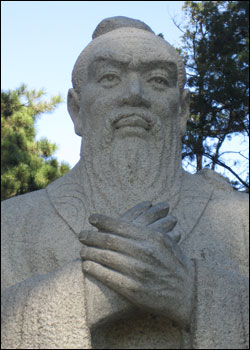
Under the Chinese domination, Confucianism had yet to gain a position in the Vietnamese society. The official adoption of Confucianism had not been recorded until 1070 when King Ly Thai To built Van Mieu (the Temple of Literature) to worship Chu Cong and Khong Tu (Confucius). In the 15th century, due to the need of constructing a unified nation, a centralized administration and a social order, Confucianism took the place of Buddhism to become a national religion under the Le dynasty. Confucianism, mostly Song Confucianism that took root deep into the social and political structure, the system of education and examinations and the circle of Confucian scholars gradually dominated social and moral life. However, Confucianism was only accepted to Vietnam in specific factors, particularly on politics and morality, rather than its entire system.

The second largest foreign religion in Vietnam is Catholicism, with about six million followers. Catholicism was introduced to Vietnam by Spanish, Portuguese, and French missionaries early in the 17th century. There are now more than 6,000 churches engaged in religious activities throughout the country. More than 500 churches damaged during the U.S. air war against Vietnam are being rebuilt.
Christianity came to Vietnam in the 17th century as an intermediary of the Western culture and colonialism. It made use of the favourable opportunity in which feudalism was in crisis, Buddhism was depraved and Confucianism was in deadlock to become a spiritual relief of a part of the population. However, this religion failed to integrate into the Vietnamese culture for a long time. Christians had to set up an altar dedicated to Jesus Christ right at their homes. Only when the Gospel was introduced into Vietnam, Christianity was able to gain a position. In 1993, there were 5 million Catholics and nearly half a million Protestants.
Foreign religions imported to Vietnam did not exterminate the local folk beliefs, but they mixed with each other to derive specific variants for both sides. For example, Taoism could not lower the women’s role, which was reflected by widespread worship of Mau (Goddess). The features of polytheism, democracy, and community are manifested by the worship of groups of ancestors, and pairs of gods. Entering a pagoda, people can easily recognize that not only Buddha but also gods and even human are worshiped there. Perhaps, only in Vietnam, there were legends that a toad dares to sue Heaven or a human being marries a fairy. These are the prominent features of Vietnamese beliefs.
History of beliefs and religions
The Vietnamese folk beliefs since the ancient time consist of belief in fertility, worship of nature and worship of man. Human beings need to be reproduced; crops need to be lushly green for the nourishment and development of life, so belief in fertility came into existence.
Among the human-revering beliefs, the custom of worshiping ancestors is the most popular, which nearly become one belief of the Vietnamese (also called Dao Ong Ba in the Cochin China). The Vietnamese choose the death-day rather than the birthday to hold a commemorative anniversary for the deceased. Every family worships Tho cong, or the God of Home, who takes care of the home and blesses the family. Every village worships its Thanh hoang, the God of the village, who protects and guides the whole village. The whole nation worships the very first kings, sharing the common ancestors' death anniversary (the Ritual of Hung Temple). Particularly, the worship of Tu Bat Tu, or the Four Immortal Gods, namely, God Tan Vien (preventing flooding), God Giong (resisting and defeating foreign invaders), God Chu Dong Tu (together with his wife growing out of poverty to consistently build his fortune) and Goddess Lieu Hanh (heavenly princess who left Heaven for the earth in the yearning for happiness) has been regarded as extremely beautiful national values.

No comments:
Post a Comment